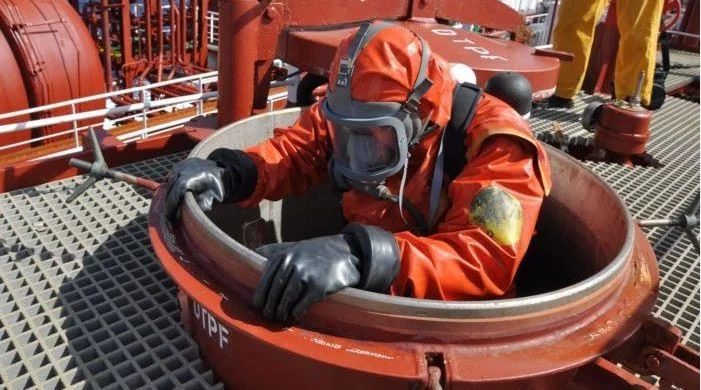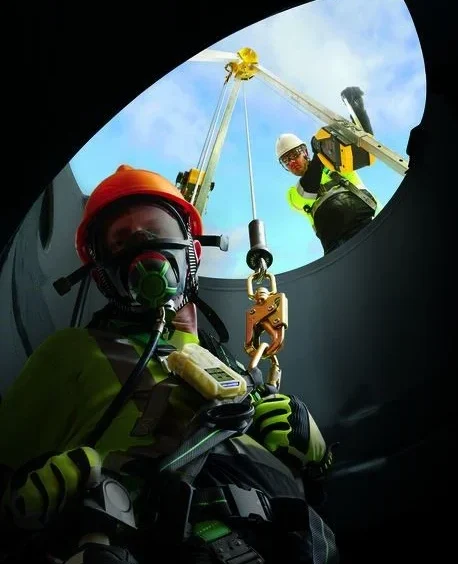
Stepping into an enclosed space on a ship isn’t just another tick on the job sheet — it’s one of the riskiest things a mariner can do. Despite years of training and checklists, incidents still happen, often because someone assumed “it’s probably safe.”
This blog walks through the practical side of enclosed space entry — what makes these areas dangerous, what the correct entry procedure looks like, and the finer details that experienced mariners never overlook.
What Qualifies as an Enclosed Space?
It’s any space on board that has:
Limited or no natural ventilation
Restricted entry or exit points
Not designed for people to be inside continuously
Common examples include ballast tanks, cofferdams, pump rooms, double bottoms, chain lockers, and sometimes even cargo holds depending on cargo history. Even if a space appears clear and harmless, it can still pose serious hidden dangers.
Why These Spaces Are Dangerous
The primary dangers come from:
- Lack of oxygen
- Presence of toxic gases
- Flammable atmospheres
- Limited visibility and difficult access in emergencies
These risks often go unnoticed until it’s too late. Gases can settle at the bottom or leak slowly into spaces over time. And once inside, getting out quickly is rarely simple.
Atmospheric Testing: What Are You Really Breathing?
Before entry, the space’s atmosphere must be tested — and this is not just about checking once and calling it good. Here’s what needs to be looked at:
🔹 Oxygen (O₂)
Typical clean air has 20.9% oxygen. The safe range for entry is between 19.5% and 23.5%.
Below 19.5%, you’re in an oxygen-deficient environment, which can lead to unconsciousness.
Above 23.5%, you’re in an oxygen-enriched space — a fire hazard waiting to happen.
🔹 Flammable Gases
Flammable gases are evaluated in relation to their Lower Explosive Limit (LEL). If the reading touches 10% of the LEL or higher, the space is considered hazardous and entry must not be attempted. Always ventilate and retest until it reads below that threshold.
🔹 Toxic Gases
Depending on previous cargo or tank history, you may find:
Hydrogen sulfide (H₂S) — toxic even in small amounts. Keep it well below 20 ppm.
Carbon monoxide (CO) — should stay under 50 ppm.
Always test at three levels — top, mid, and bottom — since heavier gases settle and lighter ones rise.
Testing should be done using calibrated detectors and before anyone even pops their head inside. If mechanical ventilation has been used, pause it briefly during testing for accurate readings.
Entry Procedure: Step-by-Step
- Risk Assessment & Permit-to-Work
- Carry out a hazard evaluation.
- Secure a permit signed by the officer in charge.
- Ventilation
- Start mechanical ventilation well before entry and keep it running.
- Avoid assuming that an open hatch equals fresh air.
- Team Arrangement–At least three personnel: one enters, one stands by, one monitors.
- Lifeline, harness, communication equipment — all must be in place.
- Rescue Equipment- SCBA sets and a tripod with winch should be ready nearby.
- No point having safety gear locked up in another compartment.
- Lighting & Tools-Explosion-proof lighting only. No exceptions.
- Use non-sparking tools where required.
- Communication- Use radios or pre-agreed signals. Shouting doesn’t count.
- Regular check-ins with the standby watch are a must.
- Exit and Debrief
- Reassess the space before sealing it again.
- Report any abnormalities. Update risk logs as needed.
What Gets Missed — But Shouldn’t
- Testing only at the entry point and not at different heights
- Skipping checks on tank lids or pockets where gases may sit
- Poor briefings or relying on “senior crew experience” over procedures
- Not keeping rescue gear ready — because “it’s a five-minute job”
These are not hypotheticals — they’re reasons behind many of the fatalities that have happened in what were assumed to be safe environments.
Final Word
Enclosed space entry is serious business. No matter how many times you’ve done it, the rules never change — and neither should your caution. A moment of carelessness can cost a life.
Keep your meters calibrated, your procedures sharp, and never treat a confined space like just another compartment. Because when things go wrong in there, you don’t get a second chance


